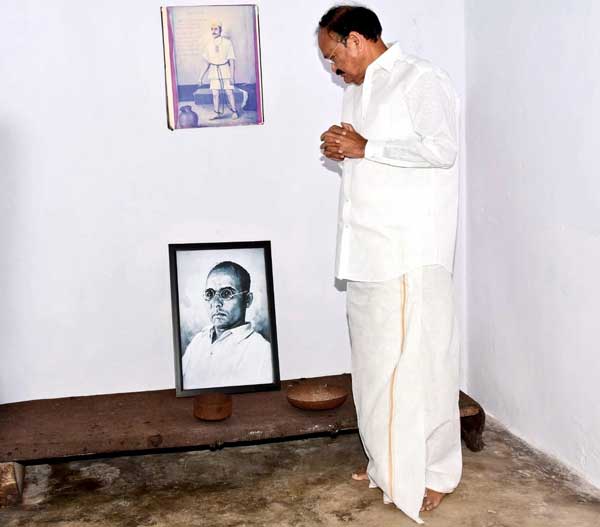Vinayak Damodar Savarkar, popularly known as Veer Savarkar, who was on the frontline of India’s freedom, is amongst those rare individuals who have the potential to emerge like a phoenix from the dust of history despite unparalleled advocacy against him by a segment of his rivals. It is imperative to understand the ideals of the accomplished writer, a very sharp lawyer, a poet and a playwright, in a nuanced and comprehensive manner.
Savarkar preferred scientific reasoning to religious customs. He had quoted BR Ambedkar several times while advocating social reforms, harmony, and the upliftment of the downtrodden. In his book, Savarkar: Echoes from a Forgotten Past, 1883–1924, Vikram Sampath documents how Savarkar appealed that “every true Indian need to resolve in his or her mind to absolve oneself of… seven fetters”, that is, Vedoktabandi i.e. exclusivity of access to Vedic literature, Vyavasayabandi i.e. continuation of a profession by virtue of one’s birth, Sparshabandi i.e. practices of untouchability, Samudrabandi i.e. forbidding the crossing of the seas to go to foreign lands, Shuddhibandi i.e. disallowing reconversions to Hinduism, Rotibandi i.e. the practice of inter-caste dining and Betibandi i.e. rigidity in abolishing inter-caste marriage. These reformist ideas became provisions under the Indian Constitution later.
Born in 1883, Savarkar was head of his times, that the rest of humanity might still need a couple of decades to catch with him or value him.
So much was his brilliance, that a book on the history of the 1857 revolution written by him, – The Indian War of Independence-1857, was banned by several countries even before it’s publication. This book was initially written in Marathi. At the time of its publication, Savarkar was 26 only.
Even today, too many people, the title of the book might suggest some ideological leaning or something related to emotions. But no, it was a hallmark of deep research to undo a fake narrative of 1857 being a sepoy mutiny. In fact, Savarkar penned it in response to celebrations in Britain of the 50th anniversary of the 1857 Indian uprising. Several Indian students helped Savarkar secretly.
He dug into the records from India Office archives. Indian nationalists in Britain like Madame Cama, VVS Iyer and MPT Acharya and many more supported him in this venture. Several Indian students in Britain, who were afraid of openly supporting Savarkar, helped him secretly. Savarkar described the 1857 revolt as a unified and national uprising of India as a nation against British authority, as great an attempt as the French Revolution and the American Revolution.
This was 1909, and the footprint of a great hero could be seen there itself as the Marathi edition was banned in British India even before its publication. Britain and France refused to publish the English version too.
Finally, It was printed in the Netherlands, as the British sleuths could not smell it having reached there in time. Even there, it was printed with false dustwrappers and copies was smuggled to India disguised as some popular and classic literature. The book remained banned in India for good 40 years. That was the might of Savarkar’s thoughts and words. British rule in India was not only badly shaken by Savarkar, but in fact, was too scared of him.
In the year 1910, Savarkar was arrested and ordered to be extradited to India. While the ship was docked at Marseilles, Savarkar escaped it. He was caught as the team to pick him from the port could not reach him in time. He was made a political prisoner in France and the case against him be handed over back to Britain reached the International Court of Justice in The Hague. This was the first case of its own type. However, the French officials handed him back to British India.
On reaching India, Savarkar was sentenced to two life terms of imprisonment totalling fifty years and was moved to the Cellular Jail in the Andaman and Nicobar Islands. When Savarkar was sentenced to solitary confinement in the Andaman prison, he wrote poems on the walls of his cell with nails and coals. Nearly 10,000 letters written here were memorised by him and rewritten after he was released from prison.
Savarkar was also the first political leader to set independence as India’s goal in the 19th century. Almost immediately after joining college, he had started organising and spreading his anti-British and revolutionary ideas through his efficient oratory and writing skills — Congress accepted this goal much later in its Lahore session in 1929. His courage is evident from the fact that he tried to escape to France by jumping off a British ship near the French coast in 1910. It is also interesting that more than a century ago, it was Savarkar who caused the two colonial powers of that time, Britain and France, to approach the Permanent Court of Arbitration, which shares space with the International Court of Justice at the Hague. And, through his extraordinary efforts, he provided leadership to several other young Bravehearts in London and across Europe to garner support for India’s freedom.
Savarkar’s ideas of modernity, social and religious reforms, cultivation of scientific temper and embracing technological tools continue to be relevant for building a new India. In 1948, Savarkar was accused of being an accomplice in Mahatma Gandhi’s murder, which could not be proved. He breathed his last on 26 February 1966.

















Related Items
Trump’s Conspiracy: India’s Trap or Golden Opportunity?
India’s chaotic and undisciplined progress…
How India and the US connect through travel…